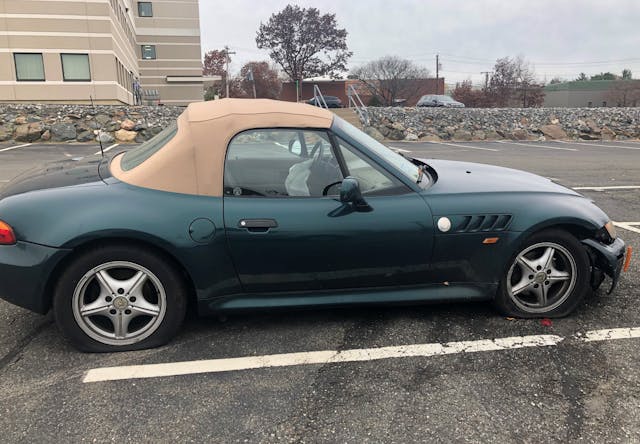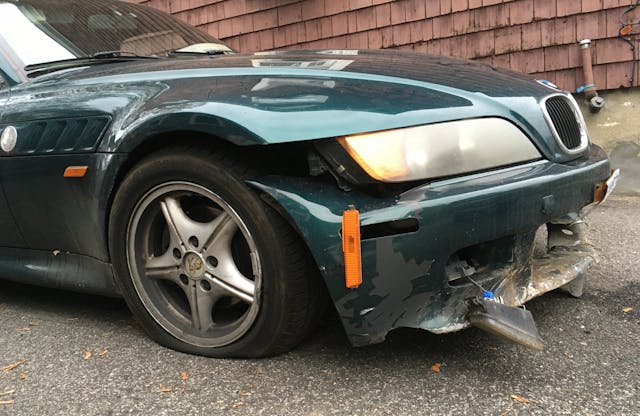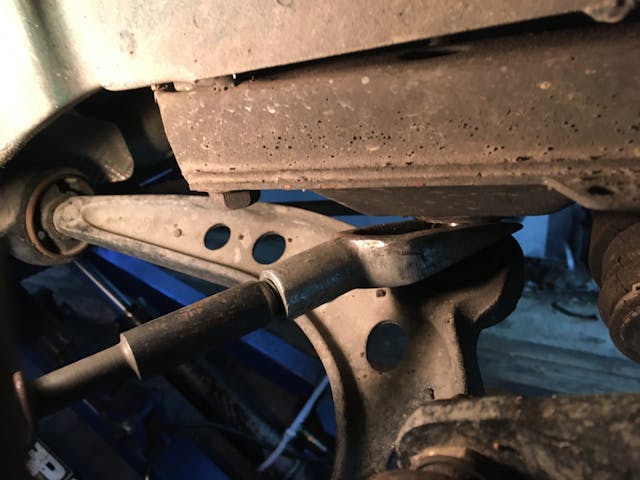Media | Articles
The Resurrection of Zelda: Fixing a curb override on a budget

I used to own a 1999 BMW Z3 2.3. I bought it about eight years ago and loved the car, but I sold it just before winter 2018, when I ran out of storage space. The buyer was my neighbor Kim, who in addition to being one of my wife’s and my closest friends, was one of what we called “The Cult of Zelda”—my wife’s women friends who loved the car and to whom I’d loan it for Xanax-like, stress-busting, rolling, top-down therapy sessions. After selling the car to Kim, I continued to maintain it for her, as it was literally three left turns from my house and it gave me a chance to have a little therapy of my own.
A few months back, I wrote how Zelda needed a clutch, how Kim offered to sell it back to me, and how I wavered, as I wasn’t certain that I wanted to commit all that time and my sole remaining over-winter garage space to a car I liked but had already parted with. I joked to both Kim and my wife that I was treating Zelda like the friend-zone girl I’d take to the prom only if the girls I really liked all turned me down.
Last week, all that came to a literal crashing halt. Kim’s son called to tell me that, after working a 17-hour day, he’d driven Zelda out of a parking lot, had a bit of a brain fart, swerved to avoid another car, and put the Z3 up onto a median strip surrounded by a sharp curb. He said that the airbag had deployed, the front end was damaged, and several of the tires were flat, but that he’d somehow managed to back the car off the median and return it to the parking lot. I spoke with Kim about what to do, warning her that the front-end damage and air bag deployment, even if minor, were likely to cause the insurance company to total it. She had some free tows left on her AAA account, so we agreed that hauling the car back to her house might be best, as that way I could look at it and advise her. Plus, if the insurance company totaled it and she wanted to buy it back, this way the car wouldn’t accrue any storage or impound fees.

When I went over to her house and saw the car, I felt gut-punched. While I didn’t see the sickening smashed-in-the-face-hood-up look I associate with front-end collisions, the right front wheel was mashed backwards into the wheel well, the air dam was splintered and cocked, lights were dangling, and both right-side tires were flat. Poor Zelda. I was certain that, combined with the air bag deployment, the damage was clearly enough for the insurance company to total the car. However, the longer I looked at it, the more it slowly washed over me that the only crumpled sheet metal on the car appeared to be a very small section of the back corner of the right front fender where the jammed-in wheel had pushed it up.

I jacked the nose of the car up, set it on stands, and looked under it. The front suspension of the Z3 is like other E36 BMWs (as well as the E30 and E46 that came before and after it) in that it has flat boomerang-shaped lower control arms (LCAs) with two ball joints in them and a rubber bushing in a bracket on the back. I could see that the right LCA, rather than being flat, was visibly twisted into the vertical plane from the impact. That made sense, as the right front wheel was the most badly dented of the four, and as it was the right front corner of the air dam that was detached. Clearly the car had hit the curb right-front-wheel-first. As I looked further, I saw that the right corner of the front sway bar had an impact mark from the curb. Protruding beneath the sway bar was the aluminum bracket holding on the A/C compressor’s idler pulley, or rather what was left of it; the bracket had been shattered. The bottom of the A/C condenser was bent back, and the condenser fan housing was smashed.
Marketplace
Buy and sell classics with confidence
Much of the under-engine plastic shrouding was missing, and the electrical connectors to the fan and some of the side-marker lights were pulled or torn. I could see clumps of dirt and grass in a few low-hanging places, but there was no big ugly crease mark running the length of the underbody. Visualizing the forensics of the car hitting and going over the curb, it all made sense. I’m not a body man, and I’m well aware of the risk in making non-expert assessments, but I wasn’t seeing any obvious subframe or unibody damage.

I opened the hood, and the only evidence of damage I found was that two of the fins on the mechanical cooling fan were missing, yet the radiator wasn’t mashed into the fan as you often see in even a light front-end impact. It’s likely that the fan blades broke from the jolt. As they say, it’s not the fall that kills you, but the sudden stop.
I verified that the oil and antifreeze levels were correct, then started the car and ran it for about 20 seconds. Other than an intermittent whistle/squeal that I assumed was from the idler pulley from the serpentine belt, it ran and sounded fine. I shut it off, looked under the car, and didn’t see any fluid streaming out.
Hmmmmm. Maybe Zelda’s not a goner after all.
To better assess the condition of the car, I wanted to see it sitting level, not listing to starboard with two flat right-side tires. I ran back home and got two ancient steel wheels with dry-rotted tires that were originally from my Bavaria but have the same center bore as the Z3. They wouldn’t clear the Z3’s bigger front calipers, but by moving around wheels so that the Bavaria steelies were on the back and the two non-flat Z3 wheels were on the front (I spun all four Z3 wheels and verified that all were bent from the curb strike), I set the car level. I then reached in, turned the steering wheel straight, and looked at the two front wheels. The left wheel was approximately straight, but the right wheel looked like Marty Feldman’s right eye, pointing laughably far afield (“Bend? What bend?”)
I started the car, mashed the clutch pedal to put it in gear, and was greeted by a chainsaw-level of noise from the clutch’s now-badly-deteriorated throw-out bearing. I backed it up six inches, then moved it forward six inches. As the junkyards say, runs and yard-drives. I shut it off, then took a moment and carefully pulled the right corner of the twisted air dam back around the right headlight assembly. To my delight, it snapped back into position. Suddenly, sitting level and with its face no longer drooping like a stroke victim, Zelda looked surprisingly intact.

Well, OK then.
I told Kim what I found, and we came to the kind of vague, non-specific agreement that good friends who completely trust each other make. If I could eke out the three right turns back to my house with Zelda’s walleyed scrubbing tires pulling it in two different directions, I’d put the car up on my mid-rise lift, dive in further, and give it some love. Exactly what that meant depended on what I’d find. At a minimum, I thought that if I simply replaced the obviously bent right LCA, it’d buy us options. It was likely that that repair alone would make it so the car could easily be driven back and forth between our houses, during which I could see what else it needed. And with the car mobile, Kim could sell it as is, if she wanted to (a drivable car is always worth more than an immobile one). She agreed.
While I didn’t need a full set of unbent wheels and good tires to drive five hundred feet, I immediately began pounding Craigslist and Facebook Marketplace for a good set of shoes. Miraculously, I found a complete set of Z3 wheels with one-season rubber on them for $150 and about a 40-minute drive away. I pounced. I drove them over to Kim’s, installed them, and moved the car back and forth in the driveway about 10 feet. Unfortunately, I found that, while driving forward, the right front wheel was mashed so tightly against the lower corner of the wheel well that I was concerned that driving and turning might rip up the fender.
I thought about what to do. Clearly, we could’ve just called AAA for the 500-foot tow back to my house, but where’s the fun in that? I wondered if I had a smaller wheel. Then I remembered that I had a donut spare. I dug it out from under my back porch. I tried inflating it, but it wouldn’t hold air. Then I realized—this was perfect. With it flat, the tire was both narrower and smaller in diameter. I mounted it, verified that it did the trick, waited until after sunset (there was nothing illegal about driving the partially-wrecked car with a flat tire, but some things are better done under cover of darkness), then drove Zelda, with the flashers on, at two miles per hour, with the right front tire going whubba whubba whubba and the engine still intermittently squealing and whistling, the three right turns back to my house. I backed it into the driveway and onto the mid-rise lift.

There was a problem. I’m helping a friend sell a car on Bring a Trailer, and it is currently—temporarily—at my place. In order to make room for Zelda, I had to pull my Lotus Europa out and leave it in the driveway. That night, of course, there was rain and high winds—the first weather the Lotus had seen since it had been put into storage 41 years ago. I chided myself for my impatience; had I simply waited a day I could’ve avoided the deluge. I took it as a reminder that Zelda could not usurp garage space for months or even weeks. Whatever I was going to do needed to happen within days. Quick in and out. Like meatball surgery on M*A*S*H.
That Sunday evening, I looked online at parts. If Kim or I was to keep the car, the smart move would be to replace not only the right LCA, but the left one as well and several parts that they were connected to. The original equipment manufacturer (OEM) for the front-end components is Lemforder. I found a vendor offering an 8-piece refresh kit with both LCAs, tie rods, sway bar links, and bushings, for about $300 shipped. However, I was reminded of the fact that the outer surface of the sliced-sushi-roll sized rubber bushings have to be pressed into “lollypop” brackets, and the inner surface is then pushed onto the end of the LCA. I hadn’t done one of these in decades, and while I do have a hydraulic press, I’d need to fab up some sort of a jig. Lollypop brackets with bushings already in them make the job quicker, and are sold by reputable vendors such as Febi and Meyle, but that pushed the total to $350, which together with the $150 I’d just dropped on wheels, suddenly felt like real money. Whether it was my money or Kim’s depended on whether I wound up buying the car back from her.
Actually, let’s back up a step. If an insurance company added up the cost of new front suspension components, plus a new front air dam, wheels and tires, under-carriage shrouding, A/C condenser, fan, and compressor bracket, plus airbag, lighting, and broken connectors, and the labor to install it all, it would rapidly exceed the value of a nice used Z3, much less this somewhat ratty-but-beloved one. The calculus in doing this myself was that a) my labor is free, b) I can scrounge and dumpster-dive on eBay and CL for used parts, and c) I can make judicious choices about certain things, such as gluing the air dam—which was already cracked—back together rather than replacing it. But still, doing this with the seat-of-the-pants “the unibody doesn’t look bent to me” approach carries real risk, as too much money can easily be spent when it shouldn’t be.
So I did what I often do, which is walk myself all the way down the other end of the price curve. I found an eBay auction for a right-side LCA with the bushing and bracket still attached for $30, shipped, from Maryland. The idea of making Zelda drivable for 30 bucks (well, 30 plus the wheels) was irresistible. The quoted delivery time, though, was surprisingly long, so I sent the seller a message asking if he could ship it first thing in the morning. He replied that he was out of town so shipment would be delayed a day. Because of this, I didn’t need to hit the Buy it Now immediately, so I decided to wait until I’d removed the lower control arm, as doing so might unearth other parts I needed.
The following morning, I dove in and removed Zelda’s right LCA. From 40 years of working on cars, I have a pretty good variety of pullers and separators. The tie rod separated neatly from the front of the LCA, but the attachment points of the LCA’s ball joints to the steering knuckle and the front subframe required merciless beating on a pickle fork with a hammer. This typically rips up the rubber boots on the ball joints, but the LCS was bent, so I didn’t care. I found that the sway bar links were also bent, but the tie rods seemed OK (the bend-back was accommodated by the fore-and-aft articulation on the universal joints inside the steering rack they’re attached to).

Unfortunately, when I turned the steering rack all the way to one side to rotate the right hub into position to remove one of the LCA’s attachment nuts, I felt some binding in the steering, and realized that the left front tire was hitting the inside of its wheel well. This meant that the left LCA was bent as well. The only thing that was surprising about this was that I didn’t previously notice how bent the left LCA was.
Now needing to replace both LCAs, I was standing on the edge of a slippery slope. The car was already in my garage on my lift. It would’ve been foolish not to dive in and replace anything bent I found. After all, I’d said I’d replace the right one and then drive it and see what else it needed, and now I’d found what else it needed even without driving it. But money-wise, the calculus shifted. Remember, this wasn’t my car. A good friend was trusting my decisions.
It was Monday mid-morning. I wanted to get parts on order by noon to ensure I’d have them by the weekend. I went back online, and although I’d found a good $30 right LCA and bushing/bracket, I couldn’t find a decent left one for the same price; a correct one was more like $50. A trivial difference, yes, but we all have thresholds. Knowing how I had to pound Zelda’s ball joints out with a pickle fork, and knowing that any used LCA probably had the same procedure done on it, buying these parts used only makes sense if they’re dirt cheap and/or if you’re dumping the car. Paying $80 for a pair felt like a bad move. I found a junkyard in Nebraska with both LCAs/bushings/brackets, both advertised that the ball joints needed replacement, with a “make offer” button on the auction. I sent the seller a question asking if the ball joints were OK other than the boots being torn and offered $40 shipped for the pair if they were. But really, it was silly, and I was relieved when I didn’t hear back.
Since these front suspension parts are also used for E36 3 Series sedans, there are many new brand-x parts sold on eBay; I could pick up two unbranded new Chinese LCAs and lollypop bushings/brackets for under a hundred bucks for the pair. That also felt wrong.
In the end, what felt right was spending an extra $170 (meaning a total of $250) and getting new OEM Lemforder LCAs and sway bar links (which were also bent) and Febi lollypop bushings pressed into brackets. But in doing so, the balance had suddenly tipped from what made sense if we were going to sell the car to what made sense if one of us (Kim or I) was going to hold onto it.
The question was: Which one of us? Stay tuned.
***
Rob Siegel has been writing a column (The Hack Mechanic™) for BMW CCA Roundel magazine for 34 years and is the author of seven automotive books. His new book, The Lotus Chronicles: One man’s sordid tale of passion and madness resurrecting a 40-year-dead Lotus Europa Twin Cam Special, is now available on Amazon (as are his other books), or you can order personally-inscribed copies from Rob’s website, robsiegel.com.
















